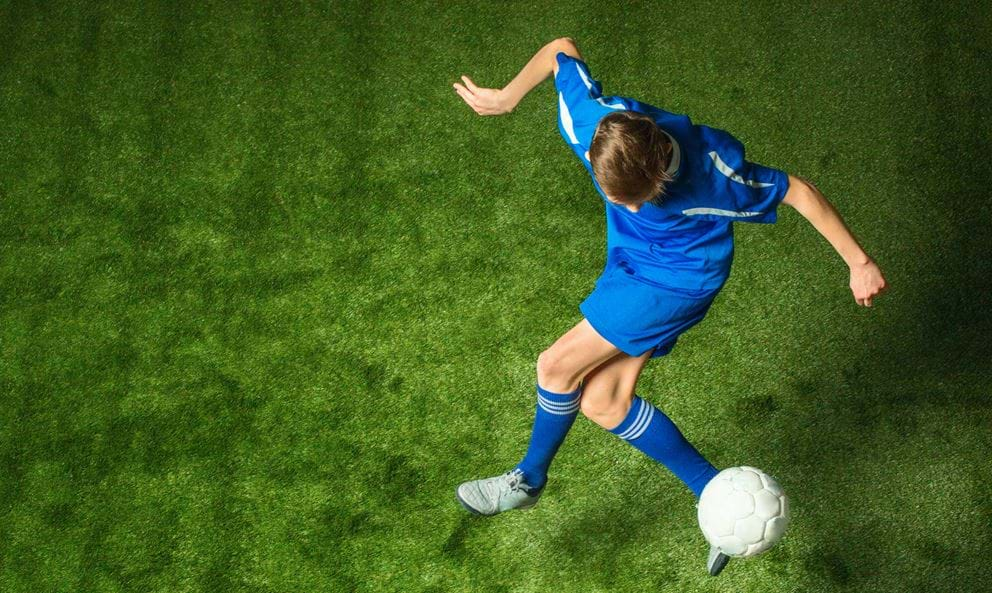How to train like a Premier League footballer

The football season is fast approaching, and while we eagerly await the first game, players are training relentlessly.
Footballers don’t follow the same exercise plan — each player trains differently based on their position and style of play. A player’s recovery and nutrition will vary too.
Want to train like Virgil Van Dijk, Sergio Aguero or Pierre-Emerick-Aubameyang? Try these exercises put together by Personal Trainer Phil Williams, when you’re next in the gym.
Player: Virgil Van Dijk
Club: Liverpool
Position: Defense (strength and power)
As a defender, Virgil Van Dijk needs to keep the pressure on opposing strikers by limiting their time on the ball. To do this, Vigil needs strength and power. Follow these exercises:
- Bulgarian split squat 4 x 6 (2-3 minute rest between sets)
- Single leg box jump 4 x 6 (2-3 minute rest between sets)
- Prowler push heavy for 10 seconds (1 minute rest between sets)
- Pendlay row SS barbell push press 3 x 6 (2-3 minute rest between sets)
These exercises build strength and power on one foot (similar to the running stance of a footballer) rather than two. The goal is to increase the weight on a weekly/bi-weekly basis.
Player: Sergio Aguero
Club: Manchester City
Position: Striker (agility and stamina)
As a striker, Sergio Aguero needs to be available at any moment. Taking a second to rest can be the difference between 1 point, and 3 points. Sergio must be agile and have excellent stamina, here’s a plan he will follow to achieve this:
- Barbell lateral lunge 3 x 12 e/s (90 seconds rest between sets)
- Ladder in-and-outs into sprint 5 sets (90 seconds rest between sets)
- Treadmill interval training 10 seconds on/20 seconds off x 8
- Prowler push lighter weight, as quick as possible (60 seconds rest between sets)
This workout can be done as 4 separate exercises, or if you want to increase the intensity as a HIIT workout, complete all 4 exercises back to back.
Player: Pierre Emerick Aubameyang
Club: Arsenal
Expertise: Speed
Aubameyang's job is to get in behind the opposing team's defensive line, closer to the goalkeeper, which is why he must be fast and agile.
- Dumbbell step-ups 3 x 6 e/s (1-2 minutes rest between sets)
- Interval sprints (10 seconds on 20 seconds off x 8)
- Hip thrusts 3 x 8 (1-2 minutes rest between sets)
- Depth drops 3 x 8 (1-2 minutes rest between sets)
Increasing speed by driving off one foot is essential for strikers. Working your lower body through single leg work, at a low rep, will increase strength and power. Depth drops will also improve reaction time.
How do footballers recover after training?
Training the right way is essential, but how do you recover properly, ready for the next match?
Footballers plan for recovery ahead of time. During pre-season, players have less recovery time as they’re continually improving their cardiovascular fitness; however, as soon as the season ends, recovery becomes a priority.
Here’s a quick checklist of how to recover properly:
- Active recovery: Light movements like walking or cycling stimulate blood flow and reduce muscle soreness.
- Increase protein intake: Protein builds and repairs muscles. 2g of protein per kg of body weight should set you on the right track for a successful recovery.
- Quality sleep: Improve your sleep quality by going to bed earlier or limiting time spent scrolling through social media/watching TV before bed. Aim for between 6 and 8 hours of sleep every night.
- Hydration: On average, a footballer will run between 8 and 12km per game. A 2% drop in hydration levels can be enough to notice a drop in performance so hydration is vital. Weigh yourself before and after training and drink 1.5x the amount of fluid you lose sweating. Aim to drink a minimum of 2 liters of water per day when you’re not training.
What do footballers eat?
Wayne Rooney once said "I tend to just have cereal before a game, probably a bowl of Coco Pops. The normal ones, not the Moons and Stars." Rio Ferdinand was spotted snacking on Jaffa Cakes at half time.
If you don’t want to reach for the cereal box or snack on biscuits before a match, here’s what most footballers eat (hint: it’s not just pasta and chicken).
- Eggs
- Oily fish
- Spinach
- Blueberries
- Beetroot
- Broccoli
- Chia seeds
Players will naturally reduce their calorie output during the off season as they’re not as active. But as pre-season begins, their energy output will increase, and more calories are needed.
Some players have different approaches for the days they are playing/training compared to rest days, as a rest day will require less energy, they may choose to reduce their calorie intake.
Although meal timing isn’t important for weight loss/gain, it’s a good idea to leave time between eating and playing. As a guide, eat carbohydrates and fat beforehand, and consume carbohydrates, fats and protein post-workout. This can vary, as some people prefer to eat close to training, whereas others find it easier to train on an empty stomach.
You’ll be training like a footballer before you know it
Even though some players are born with incredible talent, it takes grit and determination to get match ready. Don’t let that put you off though, do one exercise at a time – before you know it, you’ll be training, eating and recovering like a premier league footballer.
Thanks to Phil Williams, Personal Trainer at Manchester Spinningfields and Seb Cook, Personal Trainer at Leeds Hunslet for their contribution to this post.


